- Cisco Community
- Technology and Support
- Security
- Security Knowledge Base
- ASA Anyconnect IKEv2 configuration example
- Subscribe to RSS Feed
- Mark as New
- Mark as Read
- Bookmark
- Subscribe
- Printer Friendly Page
- Report Inappropriate Content
- Subscribe to RSS Feed
- Mark as New
- Mark as Read
- Bookmark
- Subscribe
- Printer Friendly Page
- Report Inappropriate Content
10-10-2011 10:37 AM - edited 08-28-2017 02:30 AM
Introduction
Secure VPN remote access historically has been limited to IPsec (IKEv1) and SSL. These were supported using the "Cisco VPN client" for IPsec based VPN and Anyconnect for SSL based VPN. Each of those products only supported their own protocol however with the introduction of Anyconnect Secure Mobility Client 3.0, the client can now use IPsec (IKEv2) or SSL for the transport of the VPN connection.
For SSL based configuration of Anyconnect reference http://www.cisco.com/en/US/products/ps6120/products_configuration_example09186a00808efbd2.shtml
The remainder of this document will discuss the steps to configure an ASA to support Anyconnect clients using IKEv2.
Requirements
1) ASA running version 8.4.1 or later
2) Anyconnect Secure Mobility Client 3.0 or later
3) License for Anyconnect Peer (either "AnyConnect Essentials" or "AnyConnect Permium Peers")
It is possible to configure the setup either through ASDM or via the CLI. Using the former is the easiest and is listed below along with the CLI commands that are generated.
Configure via ASDM
1) Start ASDM
2) Wizards -> VPN Wizards -> AnyConnect Wizard
3) Configure a name for the tunnel group - RemoteAccessIKEv2
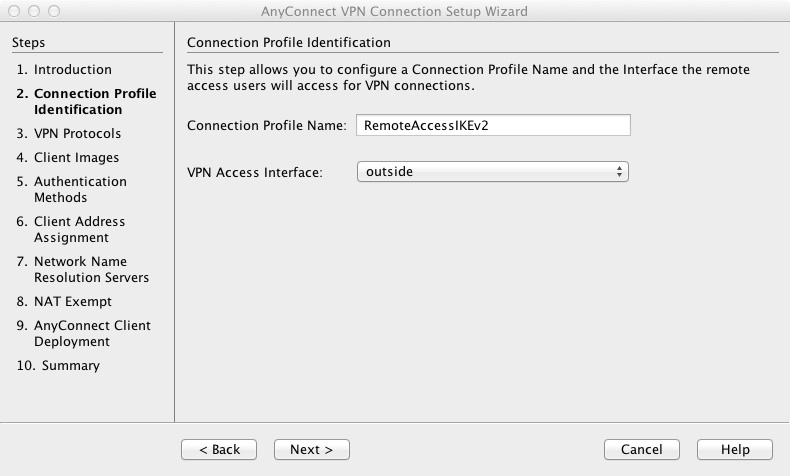
4) Configure the connection protocols. It is possible to have both SSL and IPsec connections on the same tunnel group however in this example only IPsec will be selected.
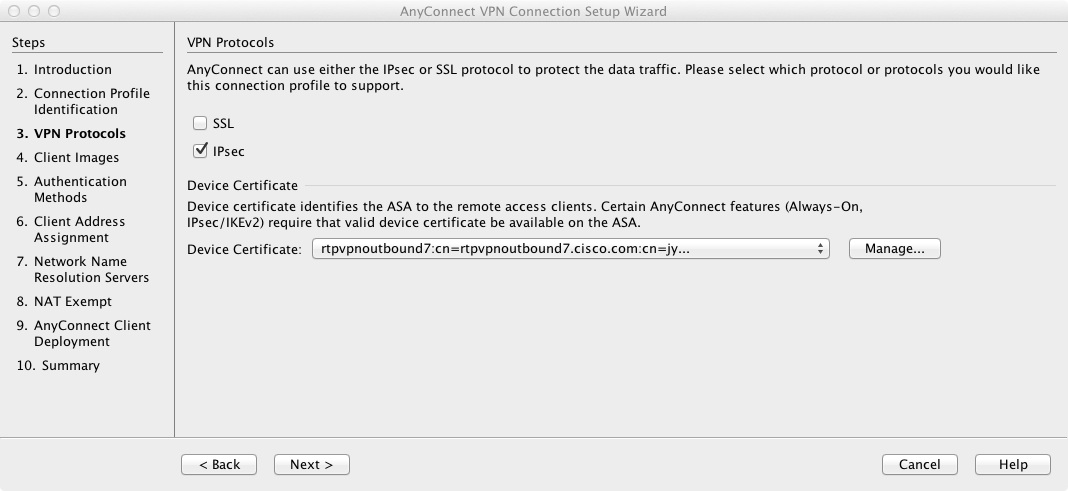
5) Upload Anyconnect images to the ASA for each platform that need supporting (Windows, Mac, Linux)
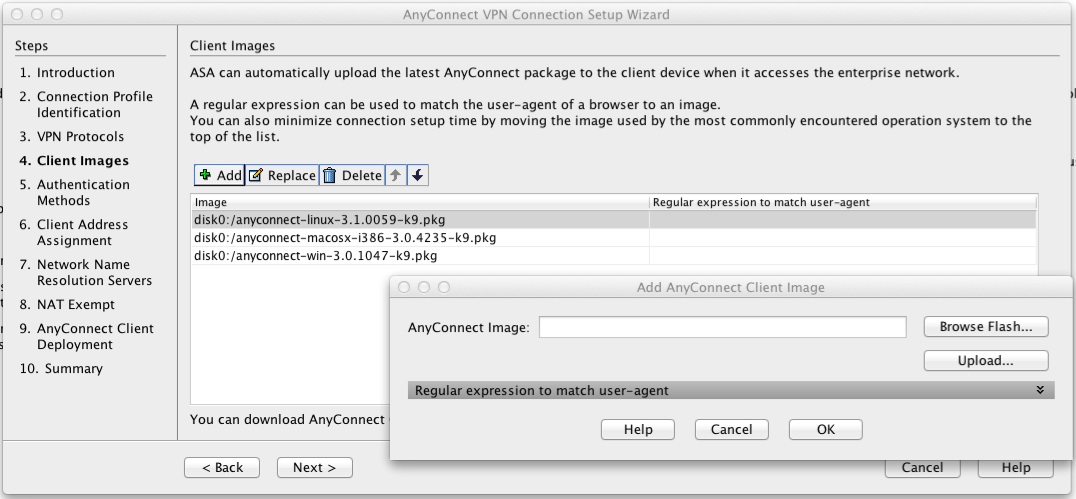
6) Configure the user database. If using the Local database users can be added/removed here. If using a remote authentication server configure a new "AAA Server Group" by clicking on the "New..." button.
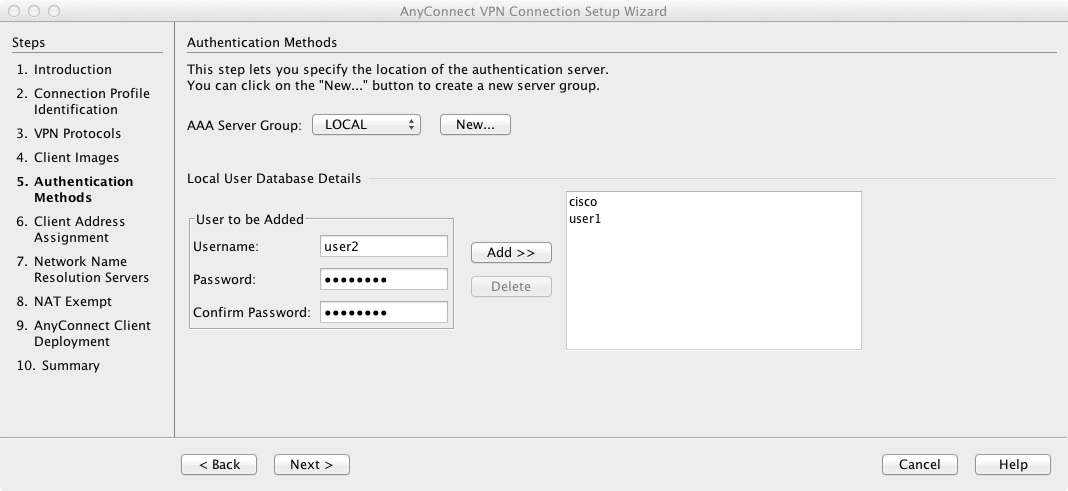
7) Create a pool of addresses that will get assigned to the vpn clients.
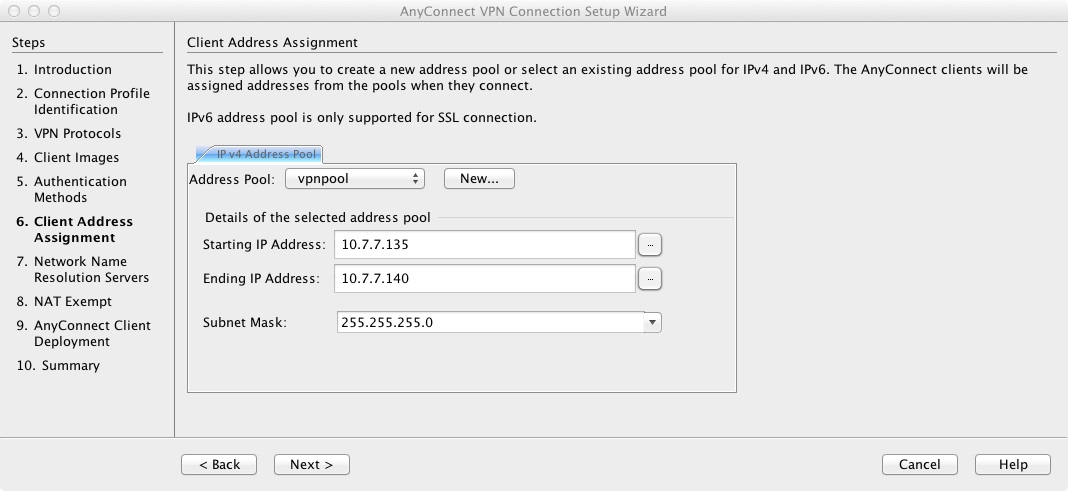
8) Define the default domain name for the virtual adapter on the client and the internal DNS servers
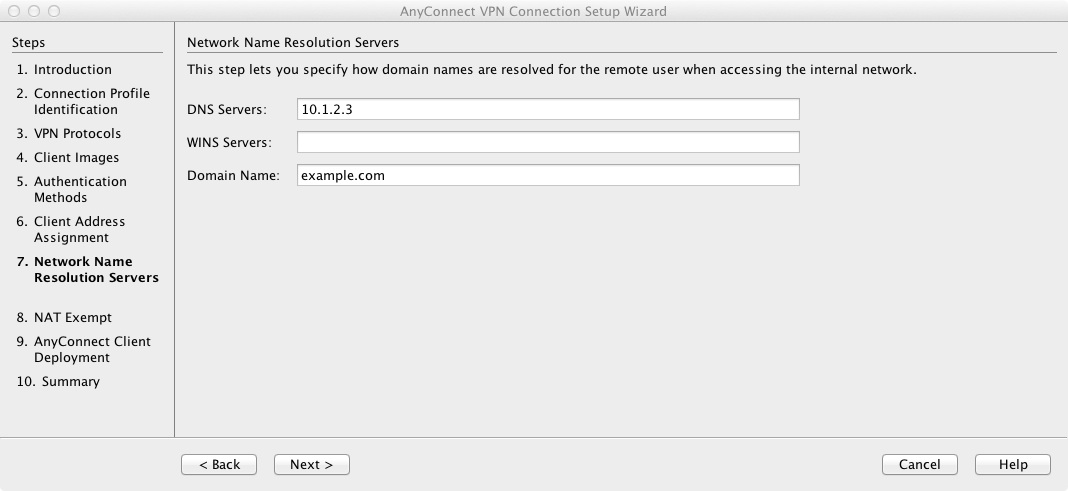
9) Allow the VPN traffic to be exempted from NAT when accessing the internal network.

10) Turn off Web Launch. This is optional and would require the client to be pre-deployed (much in the same fashion as the Cisco VPN client).
If you wish to keep Web Launch on then SSL must also be checked on step 3.
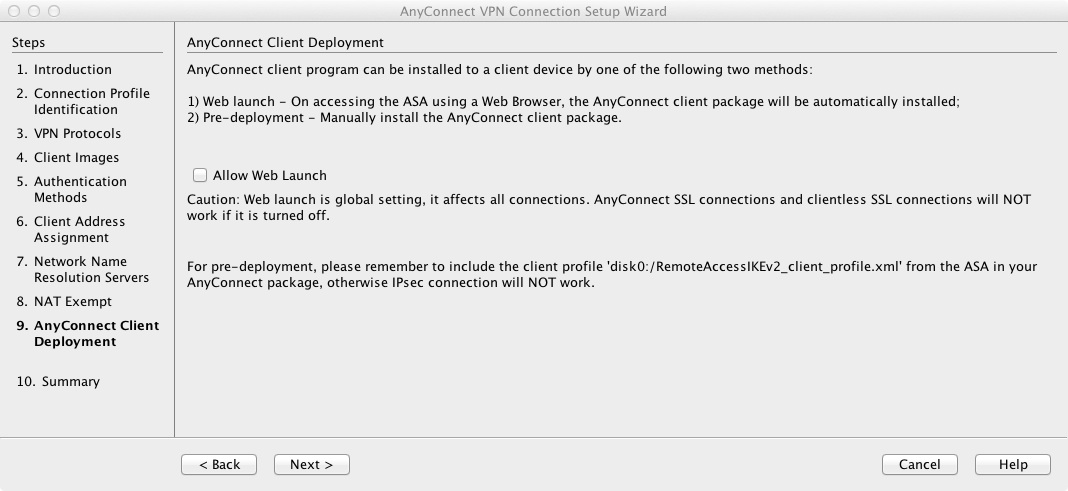
11) Save and Apply the configuration
At this point the ASA will have these commands added:
CommandsFunction
crypto ikev2 policy 1 encryption aes-256 integrity sha group 5 2 1 prf sha lifetime seconds 86400 crypto ikev2 policy 10 encryption aes-192 integrity sha group 2 prf sha lifetime seconds 86400 crypto ikev2 policy 20 encryption aes integrity sha group 2 prf sha lifetime seconds 86400 crypto ikev2 policy 30 encryption 3des integrity sha group 2 prf sha lifetime seconds 86400 crypto ikev2 policy 40 encryption des integrity sha group 2 prf sha lifetime seconds 86400 crypto ikev2 enable outside client-services port 443 crypto ikev2 remote-access trustpoint rtpvpnoutbound7 | This is adding the IKEv2 Policies. It also specifiies the certificate the ASA uses for IKEv2. |
crypto ikev2 enable outside client-services port 443 ssl trust-point rtpvpnoutbound7 outside |
Enabling client-services on the outside interface. It also specifies the certificate the ASA uses for SSL. client-services run over SSL. |
crypto ipsec ikev2 ipsec-proposal DES protocol esp encryption des protocol esp integrity sha-1 md5 crypto ipsec ikev2 ipsec-proposal 3DES protocol esp encryption 3des protocol esp integrity sha-1 md5 crypto ipsec ikev2 ipsec-proposal AES protocol esp encryption aes protocol esp integrity sha-1 md5 crypto ipsec ikev2 ipsec-proposal AES192 protocol esp encryption aes-192 protocol esp integrity sha-1 md5 crypto ipsec ikev2 ipsec-proposal AES256 protocol esp encryption aes-256 protocol esp integrity sha-1 md5 | These define the transform sets that IKEv2 can use. |
crypto map out-map 65000 ipsec-isakmp dynamic out-dyn-map crypto map out-map interface outside crypto dynamic-map out-dyn-map 10 set ikev2 ipsec-proposal AES256 AES192 AES 3DES DES | This configures the crypto map to use the IKEv2 transform-sets |
webvpn anyconnect image disk0:/anyconnect-linux-3.1.0059-k9.pkg 1 anyconnect image disk0:/anyconnect-macosx-i386-3.0.4235-k9.pkg 2 anyconnect image disk0:/anyconnect-win-3.0.1047-k9.pkg 5 anyconnect profiles RemoteAccessIKEv2_client_profile disk0:/RemoteAccessIKEv2_client_profile.xml anyconnect enable | This configures the ASA to allow Anyconnect connections and the valid Anyconnect images. If Web Launch is allowed it will install the clients on the computers on first connect.
In addition there is the programming of the profile that will be used by the client. |
group-policy GroupPolicy_RemoteAccessIKEv2 internal group-policy GroupPolicy_RemoteAccessIKEv2 attributes vpn-tunnel-protocol ikev2 dns-server value 10.1.2.3 wins-server none default-domain value example.com webvpn anyconnect profiles value RemoteAccessIKEv2_client_profile type user | This configures the group-policy to allow IKEv2 connections and defines which Anyconnect profile for the user. |
ip local pool vpnpool 10.7.7.135-10.7.7.140 mask 255.255.255.0 | This defines a pool of addresses. |
tunnel-group RemoteAccessIKEv2 type remote-access tunnel-group RemoteAccessIKEv2 general-attributes default-group-policy GroupPolicy_RemoteAccessIKEv2 address-pool vpnpool tunnel-group RemoteAccessIKEv2 webvpn-attributes group-alias RemoteAccessIKEv2 enable | This ties the pool of addressess to the vpn connection. |
object network NETWORK_OBJ_10.7.7.128_28 subnet 10.7.7.128 255.255.255.240 | Defines an object (will be used later) |
nat (inside,outside) 8 source static any any destination static NETWORK_OBJ_10.7.7.128_28 NETWORK_OBJ_10.7.7.128_28 | Defines the NAT rule that exempts the vpn traffic from being NATted. |
<?xml version="1.0" encoding="UTF-8"?> <AnyConnectProfile xmlns="http://schemas.xmlsoap.org/encoding/"> <ServerList> <HostEntry> <HostName>vpn.example.com (IPsec)</HostName> <HostAddress>203.0.113.10</HostAddress> <PrimaryProtocol>IPsec</PrimaryProtocol> </HostEntry> </ServerList> </AnyConnectProfile> | This is the contents of the profile that gets written the ASA flash as RemoteAccessIKEv2_client_profile.xml |
Testing
If Web Launch was configured, on the client open up a web-browser and log into the ASA. The client will self download and install. It will connect with TLS/DTLS first. If you disconnect, quit the client, then restart the client there will be a drop down entry for the IKEv2 connection. Select it and the client will initate using IKEv2.
If Web Launch was not configured it will be necessary to manually install the client on the computer and to copy the
RemoteAccessIKEv2_client_profile.xml into the profile directory. Start the client and select the drop down. The connection will be initiated using IKEv2.
The packages to download are :
OSPackage
| Windows | anyconnect-win-X.Y.ZZZZ-pre-deploy-k9.iso |
| Mac OS X | anyconnect-macosx-i386-X.Y.ZZZZ-k9.dmg |
| Linux | anyconnect-predeploy-linux-X.Y.ZZZZ-k9.tar.gz or anyconnect-predeploy-linux-64-X.Y.ZZZZ-k9.tar.gz |
The profile locations are:
OSLocation
| Windows XP | %ALLUSERSPROFILE%\Application Data\Cisco\Cisco AnyConnect Secure Mobility Client\Profile |
| Windows Vista/7 | %PROGRAMDATA%\Cisco\Cisco AnyConnect Secure Mobility Client\Profile |
| Mac OS X | /opt/cisco/anyconnect/profile/ |
| Linux | /opt/cisco/anyconnect/profile/ |
Caveats and Implemention notes
Certificates:
- Although RFC 4809 states the Extended Key Usage (or the lack of) extension within the client and server certificate should not prevent successful IKE establishment the ASA has a set of requirements:
1) All client certificates must have the EKU extension with the value of "client authentication".
2) The ASA certificate must have the EKU extension with the value of "server authentication"
The ASA is deviating from the RFC in a more conservative manner. It was chosen to be stricter, because if EKU were ignored, then it would be possible to build a IKE connection using a certificate granted soley for the use of "email signing" (or any other usage). This effectively defeats the security controls added in PKI.
- Currently if client-services is used the certificate for SSL and IKEv2 must reference the same trustpoint. This is documented in CSCty43072 and will be fixed in AnyConnect version 3.1.
- Mark as Read
- Mark as New
- Bookmark
- Permalink
- Report Inappropriate Content
Hi Jay,
Although this post is quite old, I hope that wil get some input from you.
As you know that Cisco IPSec Client VPN is already EOL. We have Cisco IPSec Client VPN (RA VPN) configured (many groups/profiles) on our firewall and now looking to have smooth migration option to use with AnyConnect Secure Mobility Client.
1. Is there a way that AnyConnect client can use the same IPsec profile (group-name, pre-shared key etc), if so where will that be configured on AnyConnect Client..?. can AnyConnect profile (XML) file will use for this..?
2. Can AnyConnect also use all IPsec Client VPN features such as vpn-filter, split tunnel, client access rule, simultenous login, client IP via DHCP etc.?
3. Is there any migration tool to use (convert) IPSec RA VPN to AnyConnect..?
Appreciate if you can give us some advise on this as currently there are many IPSec RA VPN groups with different configuration settings and we need to have all of them same and still use AnyConnect client as IPSec Client is already on EOL. http://www.cisco.com/c/en/us/products/collateral/security/vpn-client/end_of_life_c51-680819.html
Thanks in advance.
- Mark as Read
- Mark as New
- Bookmark
- Permalink
- Report Inappropriate Content
1) Anyconnect (using IKEv2 or SSLVPN) doesn't use a pre-shared-key to authenticate the user. A certificate will be used to authenticate the ASA and either/both user+pass and certificate is used to authenticate the user. The XML profile is needed just to make the Anyconnect client use IKEv2 rather than the default of SSL when connecting to the ASA.
You can still use the same tunnel-groups and group-policies. Just make sure "vpn-tunnel-protocol" in the group-policy allows the method you are trying to connect with.
2) Yup - configuration of those attributes are retained and supported with Anyconnect
3) Via the command line, there is a command that will do most of the work for you "migrate remote-access ikev2"
- Mark as Read
- Mark as New
- Bookmark
- Permalink
- Report Inappropriate Content
Hi Jay,
Many thanks for your response.. just one more question..
Is the certificate is must for authentication, or can we use only username/password.?
I see there are few caveats when using certificate.
Thanks..
- Mark as Read
- Mark as New
- Bookmark
- Permalink
- Report Inappropriate Content
For SSLVPN and IKEv2 (remote-access) the headend (ASA) must use a certificate.
The user can use:
a) Just a certificate
b) Just a user/pass
c) Both a certificate and user/pass (2 factor authentication)
Hope that helps
- Mark as Read
- Mark as New
- Bookmark
- Permalink
- Report Inappropriate Content
I have anyconnect working before, i can login and see the display but i can't browse the internet , i try to fix it, in that process , my anyconnect stop working, each time i try to reload the image i get this message " error unable to load anyconnect image-extraction failed " any suggest please .
- Mark as Read
- Mark as New
- Bookmark
- Permalink
- Report Inappropriate Content
What needs to be changed in order to authenticate using Smart Cards?
- Mark as Read
- Mark as New
- Bookmark
- Permalink
- Report Inappropriate Content
Christine,
Hopefully this document should help you identify the missing pieces.
http://www.cisco.com/image/gif/paws/107237/CAC-Anyconnect.pdf
-Jay
- Mark as Read
- Mark as New
- Bookmark
- Permalink
- Report Inappropriate Content
Thank you for your response. This helps immensely.
- Mark as Read
- Mark as New
- Bookmark
- Permalink
- Report Inappropriate Content
Jay, in a recent thread you provided a link to a CAC and AnyConnect VPN document. http://www.cisco.com/image/gif/paws/107237/CAC-Anyconnect.pdf
This actually refers to the Cisco VPN client. Do you have a document that specifically is used for CAC and AnyConnect? Preferably 9.x and up. The DOD has mandated two factored authentication via NIST policy that is becoming the rule. Thanks!
- Mark as Read
- Mark as New
- Bookmark
- Permalink
- Report Inappropriate Content
Hi, Jay
Thank you for your great post.
I can connect with AnyConnect IKEv2 when I follow preocedures.
There is no UserGroup in your sample profile, but is it not any problem IKEv2 works?
I have read the note in the link below but I am thinking the UserGroup is only used with a Group-url setting in a configuration.
Or when I use IKEv2, should I always set UserGroup in a profile regardless of which tunnel-group selections use?
- The UserGroup must match the name of the tunnelgroup to which the IKEv2 connection falls. If they do not match, the connection often fails and the debugs indicate a Diffie-Hellman (DH) group mismatch or a similar false negative.
Best regards,
- Mark as Read
- Mark as New
- Bookmark
- Permalink
- Report Inappropriate Content
This Does not seem correct configuration.
you should go to wizards then select from the list Remote access IKEv2 then you will get the image below
- Mark as Read
- Mark as New
- Bookmark
- Permalink
- Report Inappropriate Content
Hi,
does anyone know the OSL profile location of WIN 10? Because of special requirements, I had to configure IKEv2 manually.
Many thx
Peter
- « Previous
-
- 1
- 2
- Next »
Find answers to your questions by entering keywords or phrases in the Search bar above. New here? Use these resources to familiarize yourself with the community:
